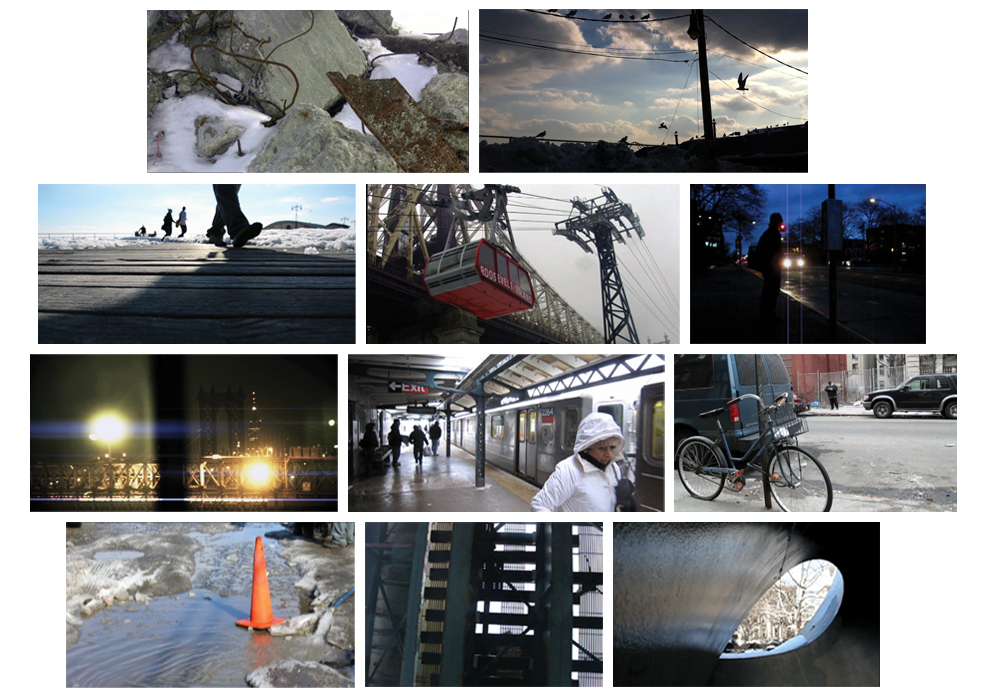
Celebrate ten years of Urban Omnibus and support ten more years of fresh, independent perspectives on citymaking with a donation today!
Celebrate ten years of Urban Omnibus and support ten more years of fresh, independent perspectives on citymaking with a donation today!
This past winter, I had the opportunity to teach a Visual Studies workshop at Columbia University’s Graduate School of Architecture, Planning and Preservation entitled “Montage City: Filmmaking as Urban Observation.” The point of the workshop was to encourage students of architecture to engage with the collection and arrangement of moving images as an exercise in interpreting the existing conditions of urban space. As a formal strategy, cinematic montage — the juxtaposition of distinct moving images to form a cohesive whole — is uniquely suited to the study of urbanism, particularly for designers learning how to propose sensitive and sophisticated interventions in the landscape.
11 students went out and documented New York locales far and wide, from City Island to Roosevelt Island, from Willets Point to the Inwood Railyards. While the methodological framework of the workshop invoked site analysis, the sites in question were not bounded in the terms of a real or imagined architectural or urban design project. Rather, the focus was on a slightly larger scale: the scale of experience that corresponds roughly to the size of a small neighborhood; or, the scale at which New Yorkers are typically able to identify a particular look and feel for a particular place.
Students were encouraged to investigate these ineffable essences in repeated visits, by shooting video of people doing things (such as shoveling snow or fixing bait to a fishing pole), of people moving through space (such as commuting on the Roosevelt Island Gondola or driving over the Brooklyn Bridge), and of details of the built environment (such as housing stock or streetscape design). Some of the sites, like Willets Point, Coney Island or Admiral’s Row at the Brooklyn Navy Yard, are facing large-scale redevelopment; others, like City Island or 138th Street in Harlem, are buffeted by subtler and slower forces of urban change. All of the sites students chose to document are undergoing some form of transformation, yet these videos are less about preserving a moment in time than about interpreting what makes a place feel a certain way.
Check out three of the student videos below:
Coney Island by Julie Jira
Julie Jira’s exploration of Coney Island opens with a subway journey to the end of the line that literally and figuratively frames her gaze on a storied landscape defined by the interaction between natural and built components: gulls alighting on docks, fishermen preparing for a catch, children playing along the shoreline. The video manages to resist the visual clichés of Coney Island without abandoning careful observation of the neighborhood’s icons: the boardwalk, the rides, the beach.
…
Willets Point by Andrew Kim
For his video, Andrew Kim lit out for Willets Point and captures a mundane task we can all relate to, digging a car out after heavy snow. In the Iron Triangle, however, with its concentration of auto body shops, scrapyards and potholes and its lack of sidewalks, sewers or the kind of stormwater drainage systems found elsewhere in the city, the rhythms of daily life are highly specific. With a subtle and consistent approach to sound as a formal element, this video sketches a brief portrait of a unique urban context and repeatedly refers to the neighborhood’s points of contact — trains entering, cars leaving, airplanes flying overhead — with the city and world beyond its borders.
…
Brooklyn Bridge by Alok Shetty
In Alok Shetty’s paean to a beloved landmark, the architectural iconicity of the Brooklyn Bridge coexists with its functional role as a vital part of the city’s traffic system. By cleverly switching between these two modes of looking at the bridge, underscored by his use of timelapse videography and music, his video articulates both the crucial necessity and the timeless indeterminacy of infrastructure.
…
These days, most use of moving images in architectural practice seems to prioritize illustrating a potential future: the proposed result of a design project as visualized by an animated fly-through or 3D massing diagram. “Montage City” was intended to get architecture students thinking about how to use the craft of nonfiction filmmaking to look closely at what’s there already and to represent aspects of urban form and experience that are not always captured in traditional site analysis: the actions and interactions of individuals; the relationship of light and shadow; the interplay of texture, shape, pattern and line; the inextricability of the social and physical attributes of the urban fabric.
The views expressed here are those of the authors only and do not reflect the position of The Architectural League of New York.

Comments